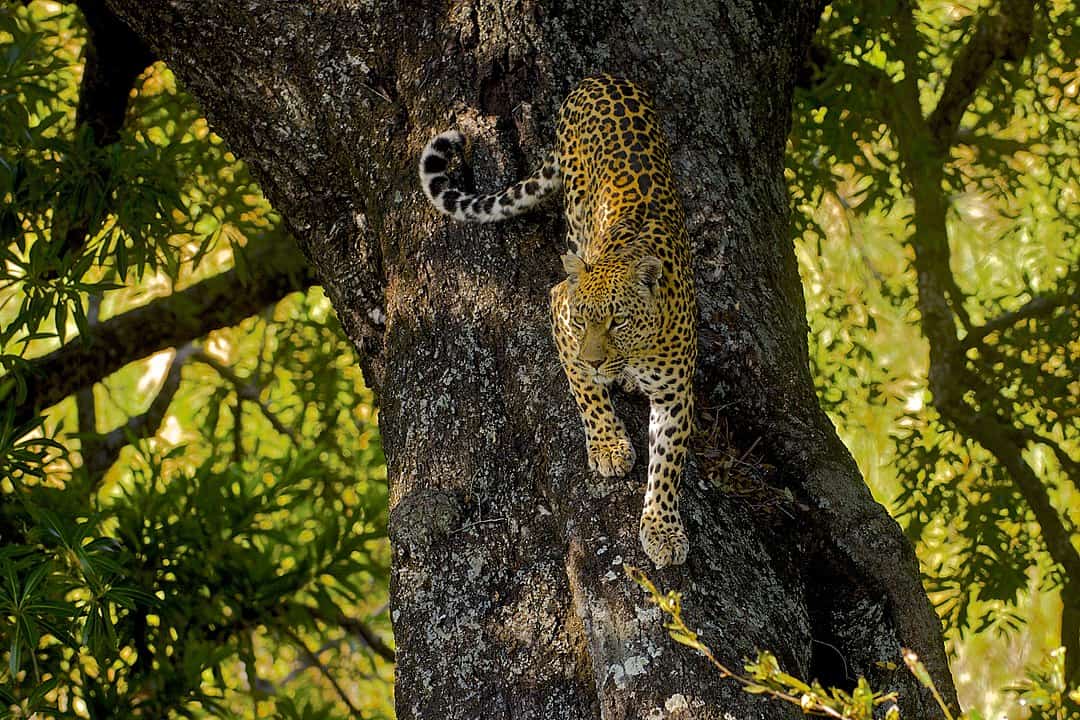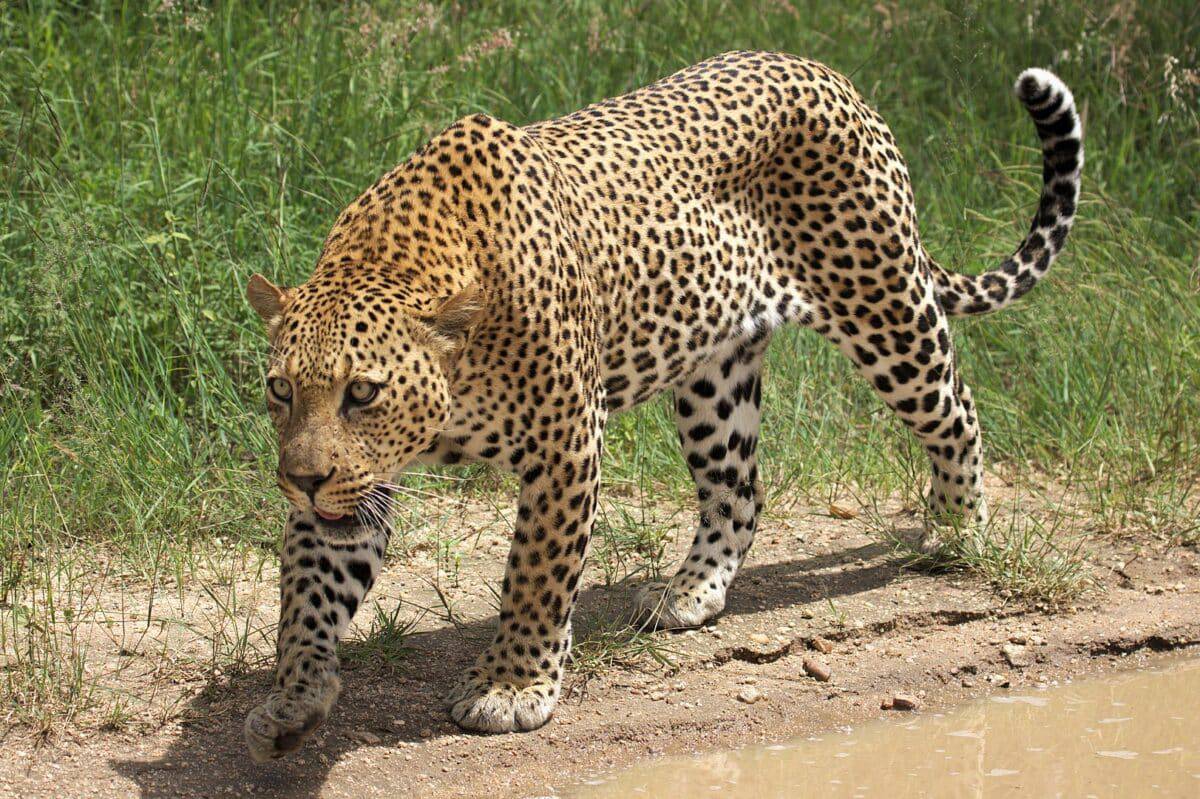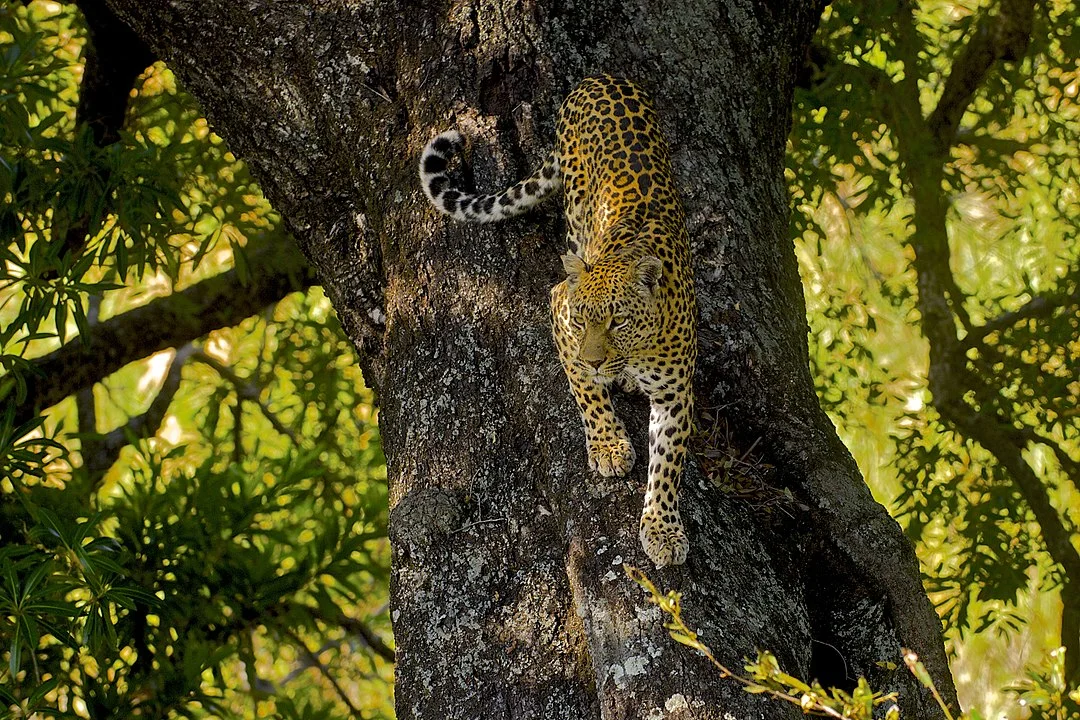Leopards are one of the most adaptable and elusive big cats. They exhibit remarkable traits and behaviors that have fascinated humans for centuries. Their ability to climb up large trees, sometimes dragging heavy prey, sets them apart from other large wild cats. Recent footage also shows their ability to ambush prey from high up in trees. This behavior is not common to all leopards, however it highlights behavior highlights their adaptability and intelligence.

The leopardess, perched silently in the tree, waits patiently for the perfect moment to strike. At first glance, she appears to be resting, even asleep, but this deceptive calm belies her readiness to pounce at a moment’s notice. Below her, a group of unsuspecting impala graze, oblivious to the lurking danger overhead. In a sudden burst of action, the leopardess launches herself from her nine-meter-high vantage point, a height surpassing that of a two-story building. Such a daring leap is risky, as they have previously suffered fatal falls from similar heights. This requires immense skill and precision, showcasing the leopardess’s hunting prowess.
Insights into Leopard Behavior and Ecology
- Masters of Stealth and Surprise: Leopards are renowned for their ability to remain undetected until the moment of attack, a skill emphasized in a report from The Telegraph.
- Arboreal Adaptations: According to the African Wildlife Report, they frequently drag their kills into trees. This behavior showcases their incredible strength and climbing skills, essential for survival in the wild.
- Solitary and Powerful Hunters: Despite being the smallest of the big cats, they are formidable hunters, capable of taking down prey larger than themselves.
- Nocturnal Predators: Leopards are primarily active at night but can also hunt during the day, especially in less disturbed environments.
- Challenges in Conservation: The leopard’s habitat has significantly diminished. Conservation efforts are crucial in protecting these animals.
- Varied Diet: Leopards have a diverse diet, allowing them to adapt to different environments and hunting opportunities.
- Reproductive Behavior: Female leopards raise their cubs in isolation, reflecting their solitary nature.
- Vulnerable Status: Leopards face numerous threats, including habitat loss and human conflict, making their conservation a priority.
Overview of Subspecies
The leopard (Panthera pardus) is a prominent member of the “big cats” family. It inhabits parts of Asia and a vast range in sub-Saharan Africa. Notably, they are characterized by longer bodies and shorter legs compared to other cat family members.
Recognized Subspecies
There are nine recognized subspecies of leopards. Each subspecies has unique characteristics and faces different conservation challenges.
Regional Variations
- Sri Lankan Leopard: Native to Sri Lanka, known for its tawny coat with close-set rosettes.
- Javan Leopard: Endemic to Indonesia’s Java, critically endangered with unique black or spotted coats.
- Indochinese Leopard: Found in southern China and Southeast Asia, facing threats from habitat loss and poaching.
- Amur Leopard: Native to southeastern Russia and northeast China, critically endangered with only about 70 individuals remaining.
- North-Chinese Leopard: Inhabits northern China, known for its darker, orangish coat.
- Persian Leopard: The largest subspecies, native to the Caucasus region, classified as endangered.
- Arabian Leopard: One of the smallest subspecies, native to the Arabian Peninsula, critically endangered.
- Indian Leopard: Found in the Indian subcontinent, listed as vulnerable with an estimated population of 12,000 to 14,000.
- African Leopard: Native to sub-Saharan Africa, facing threats from trophy hunting and habitat loss.
Conservation Status
Each leopard subspecies exhibits distinct physical traits and adaptations to their environments. However, many face critical threats, including habitat loss, poaching, and human conflict. Conservation efforts are vital to protect these diverse and adaptable big cats.

Conclusion
The leopard’s resilience in the face of adversity is as remarkable as its hunting prowess and adaptability. As we continue to marvel at their beauty and strength, it is imperative that we also commit to their conservation. Protecting these majestic creatures and their habitats is not just about preserving a species; it’s about maintaining the balance of ecosystems they help sustain. The future of leopards, in all their diversity and splendor, depends on our actions today.
You might also enjoy:
A Python’s Ambitious Attempt to Eat a Large Buck
The Fascinating World Of The Largest Lion
A New Pangolin Species Discovery Renews Hope
- Homeless Man Develops Life-Changing Friendship with a Husky - May 8, 2024
- World’s Largest Snake Discovered In Amazon Rainforest – Video - April 30, 2024
- Artificial Breeding of African Wild Dogs and the Sperm Bank Initiative - April 25, 2024

